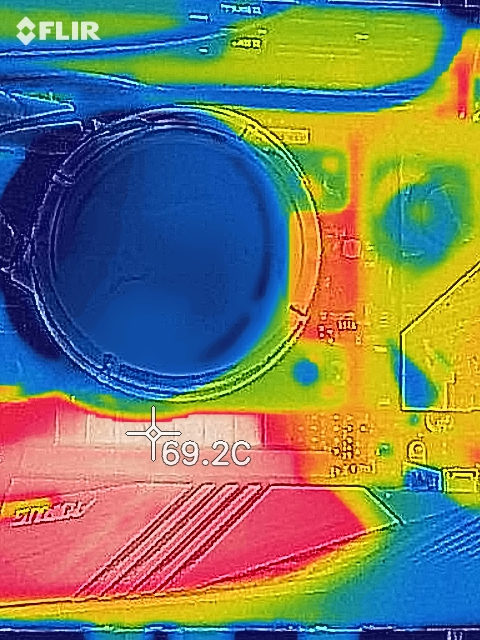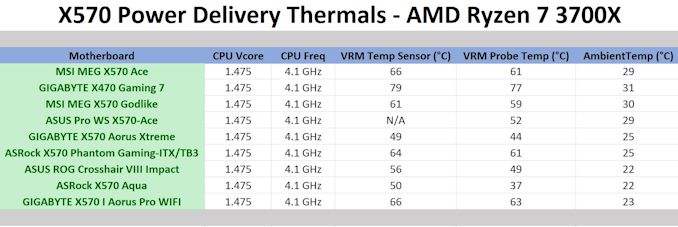On The Wings of an Eagle: GIGABYTE's X570 I Aorus Pro WIFI Motherboard Tested
by Gavin Bonshor on March 19, 2020 10:00 AM ESTPower Delivery Thermal Analysis
One of the most requested elements of our motherboard reviews revolves around the power delivery and its componentry. Aside from the quality of the components and its capability for overclocking to push out higher clock speeds which in turn improves performance, is the thermal capability of the cooling solutions implemented by manufacturers. While almost always fine for users running processors at default settings, the cooling capability of the VRMs isn't something that users should worry too much about, but for those looking to squeeze out extra performance from the CPU via overclocking, this puts extra pressure on the power delivery and in turn, generates extra heat. This is why more premium models often include heatsinks on its models with better cooling designs, heftier chunks of metal, and in some cases, even with water blocks.

The 6+2 power delivery on the GIGABYTE X570 I Aorus Pro WIFI motherboard
Testing Methodology
Out method of testing out if the power delivery and its heatsink are effective at dissipating heat, is by running an intensely heavy CPU workload for a prolonged method of time. We apply an overclock which is deemed safe and at the maximum that the silicon on our AMD Ryzen 7 3700X processor allows. We then run the Prime95 with AVX2 enabled under a torture test for an hour at the maximum stable overclock we can which puts insane pressure on the processor. We collect our data via three different methods which include the following:
- Taking a thermal image from a birds-eye view after an hour with a Flir Pro thermal imaging camera
- Securing three probes on to the rear of the PCB, right underneath CPU VCore section of the power delivery for better parity in case a probe reports a faulty reading
- Taking a reading of the VRM temperature from the sensor reading within the HWInfo monitoring application
The reason for using three different methods is that some sensors can read inaccurate temperatures, which can give very erratic results for users looking to gauge whether an overclock is too much pressure for the power delivery handle. With using a probe on the rear, it can also show the efficiency of the power stages and heatsinks as a wide margin between the probe and sensor temperature can show that the heatsink is dissipating heat and that the design is working, or that the internal sensor is massively wrong. To ensure our probe was accurate before testing, I binned 10 and selected the most accurate (within 1c of the actual temperature) for better parity in our testing.
For thermal image, we use a Flir One camera as it gives a good indication of where the heat is generated around the socket area, as some designs use different configurations and an evenly spread power delivery with good components will usually generate less heat. Manufacturers who use inefficient heatsinks and cheap out on power delivery components should run hotter than those who have invested. Of course, a $700 flagship motherboard is likely to outperform a cheaper $100 model under the same testing conditions, but it is still worth testing to see which vendors are doing things correctly.
Thermal Analysis Results

We measured 69.2°C on the hottest part of the board during our testing.
The hottest part of the heatsink was the MOSFETs
The GIGABYTE X570 I Aorus Pro WIFI is using a 6-phase power delivery for the processor with six Infineon TDA21472 70 A power stages and is controlled by an Infineon IR35201 PWM controller operating at 6+2. Cooling the board's power delivery is a small but capable heatsink which slots into the rear panel cover.
After running our VRM thermal tests, the GIGABYTE X570 I Aorus Pro WIFI performed well given the boards size in comparison to the boards we've previously tested. We observed temperatures of 66°C from the boards integrated thermal sensor, with our probes measuring 63°C attached to the rear of the power delivery. Our thermal imaging camera noted that the hottest part of the power delivery looking at the top of the board came from the MOSFETs, which we observed at just over 69°C. All our testing was done with our Ryzen 7 3700X processor and we expect the Ryzen 9 3950X processor to push the power delivery even further, and we wouldn't recommend using an overclocked 3950X in a system with this board without ensuring adequate airflow. This is due to the design of the heatsink which relies more on chassis with good airflow as opposed to a heatsink with a large mass.











63 Comments
View All Comments
V1tru - Thursday, March 19, 2020 - link
Got it since launch, usefull info:disable bluetooth/wifi powersaving in Windows device setting, or the wireless card will go crazy after standby
sonny73n - Sunday, March 22, 2020 - link
After all these years and Gigabyte motherboards’ drivers still suck.Smack0Lantern - Sunday, March 22, 2020 - link
When did Gigabyte become a designer and manufacturer of ICs for network/RF controllers? Gigabyte doesn’t write the drivers dumbassInTheMidstOfTheInBeforeCrowd - Monday, March 23, 2020 - link
Yeah, and Gigabyte didn't even choose to put these network/RF controllers with those shonky drivers on their motherboard(s). No, they didn't. A ... uh ... armed and dangerous thooth fairy forced Gigabyte to include specifically those ICs on their motherboards. Gigabyte is not the one to blame here!Nephtys - Monday, April 6, 2020 - link
These drivers are provided by Intel, not Gigabyte.joaolx - Friday, May 8, 2020 - link
Thanks for this! I read this before buying the board and came across this issue. I was going crazy with bluetooth disconnecting every minute after waking from sleep and remembered your comment.shabby - Thursday, March 19, 2020 - link
In before the "it's almost a perfect board but it's missing..." crowd.InTheMidstOfTheInBeforeCrowd - Thursday, March 19, 2020 - link
Well, it's not actually missing something, but rather has some superfluous stuff that would befit a board of such compact form factor much better when left out. I am talking about the squirrel cage fan here, which of course is necessary because X570. But then again, a small board such as this hardly benefits from all the I/O options the X570 offers. A chipset nod needing active cooling would be much nicer.Unfortunately, such a chipset doesn't exist presently and one either has to begrudingly accept either squirrel-cage-fan-X570 or B450-pardon-i-meant-B550A, or just refuse to buy this stuff
(Yeah, obviously the latter is me. I am at a point where i want to do a major system upgrade towards Ryzen, but AMDs underwhelming chipset strategy kind of erodes the confidence their latest CPU offerings instill. Not saying that Intel is presenting themselves in a more favourable light. So i am still holding off to see how things develop with regards to both players...)
Slash3 - Thursday, March 19, 2020 - link
I replaced the fan on my X570 Taichi with an HB-802 passive heatsink. Works great.Makaveli - Friday, March 20, 2020 - link
i've never heard the chipset fan once on my x570 build.I think people may a bigger deal over it than necessary.